Краткие итоги изучения древней письменности майя в Советском Союзе
Археологические исследования, развернувшиеся с конца XIX в. на территории Центральной Америки, показали, что там существовал древний очаг цивилизации такого же порядка, как Шумер или Египет. В настоящее время история Центральной Америки известна только по отрывочным полулегендарным сведениям, сохранившимся в источниках колониального периода. Все эти сведения, не говоря уж об их фрагментарности и недостоверности, относятся к событиям не раньше X в. Между тем открытые в развалинах древних городов памятники письменности майя (а также некоторых соседних народов, заимствовавших у майя письмо) охватывают громадный промежуток времени (примерно в полторы тысячи лет) и большую территорию (от мексиканского штата Вера Крус до Сальвадора); они имеются в достаточном количестве, чтобы служить солидным историческим источником. Изучение древней цивилизации Центральной Америки, которая должна занять подобающее ей место во всемирной истории, невозможно без расшифровки письменности майя.
Первые попытки расшифровки относятся к середине XIX в., когда Кингсборо опубликовал Дрезденскую иероглифическую рукопись. К этому времени путешественники (Дюпе, Стефенс) обнаружили иероглифические надписи на камне во многих местах Центральной Америки. В 1863 г. французский американист Брассер де Бурбур нашел труд Диэго де Ланда, известный под названием «Сообщения о делах в Юкатане» и относящийся к 1566 г.
Приведенный Ланда список иероглифов майя, имеющих звуковое значение (так называемый «алфавит Ланда»), послужил предметом нескончаемой полемики. Первые исследователи XIX в. пытались применить «алфавит Ланда» к чтению иероглифических текстов. Хотя они исходили из принципиально неверного предположения о чисто звуковом характере письменности майя, некоторым из них все же удалось, наряду с множеством абсурдных толкований, правильно прочесть отдельные слова в рукописях. Тем не менее неверный принцип чтения предопределил безуспешность попыток расшифровки. В большинстве случаев эти авторы полагали, что майя были связаны через Атлантиду с народами Древнего Востока, и искали прямые аналогии между письменами майя и египетскими и даже греческими. В дальнейшем исследователи отказались от попыток фонетического чтения иероглифов, признали «алфавит Ланда» плодом недоразумения и приняли тезис об идеографическом характере письменности майя. При таком подходе расшифровать письменность майя было теоретически невозможно, и дело расшифровки зашло в тупик. После того как Ферстеманн установил принцип написания чисел у майя и доказал наличие календарно-астрономических знаков в иероглифических рукописях, расшифровщики полностью переключились на изучение календаря майя. Наиболее обширные монографии о письменности майя фактически представляют. собой работы по календарю.[1] Это направление, заменяющее изучение письменности изучением календаря, к сожалению, остается господствующим до настоящего времени.
Следует отметить, что попытки расшифровки велись очень небрежно и на крайне низком теоретическом уровне. Например, попытка составить каталог знаков (с чего, казалось бы, следовало начинать) впервые была сделана только в 1931 г. (Гэйтс), притом явно неудачно: были перепутаны сложные и простые знаки, разные знаки сочтены вариантами одного и, наоборот, варианты одного сочтены разными знаками. В качестве примера фонетического знака во всех работах, от самых ранних до самых последних, неизменно фигурирует знак солнца (к'ин), встречающийся в написании слов йаш-к'ин («новое солнце», название месяца), чи-к'ин («закат солнца», «запад») и т. д., хотя именно в этих случаях он употреблен как идеограмма, что ясно уже при самом поверхностном ознакомлении с любой иероглификой. Поэтому неудивительно, что попытки фонетического чтения (последнюю сделал Ворф в 1941 г.) оказались безуспешными, а «алфавит Ланда» — опровергнутым. Дошло до того, что некоторые крупнейшие специалисты, в частности корифей немецкой американистики Пауль Шелльхас, объявили расшифровку письменности майя принципиально невозможной.
Советские ученые при изучении письменности майя исходили из своих общих взглядов на развитие общества. Иероглифическая письменность возникает на определенной стадии развития (при переходе от родового строя к классовому) у народов, живущих в различных частях света. Появление ее обусловлено едиными законами развития человеческого общества. Поэтому нет надобности объяснять сходство между древними цивилизациями Старого и Нового Света весьма мало вероятным взаимным влиянием, равно как нет возможности предполагать, что майя пользовались не иероглифической письменностью, свойственной всем древнейшим цивилизациям, а какой-то другой, например идеографической (существование которой, кстати сказать, вообще не доказано).
Многие ученые склонны назвать иероглифической вообще всякую письменность с замысловатыми знаками и поэтому называют письменность майя одновременно и иероглифической, и идеографической. Кроме того, имеется весьма ярко выраженная тенденция вообще отвергать существование иероглифической системы письма, рассматривая письменность египтян, шумерийцев и др. как переходную от идеографической к алфавитной. При этом получается, что во всех древних цивилизациях употреблялось «переходное» письмо, а исходная основная идеографическая система — ни у кого. Китайскую письменность можно назвать идеографической только по недоразумению, а после превосходной монографии Ибарра Грассо[2] невозможно более говорить об идеографическом характере древнеперуанской письменности. В действительности иероглифическое письмо возникает непосредственно из пиктографии и представляет собой древнейшую систему записи звуковой речи. Наиболее характерными признаками иероглифической системы письма является наличие трех категорий знаков (идеографические, фонетические и ключевые), многозначность знаков и приблизительность передачи фонетического состава слов.
Письменность майя возникла, повидимому, в первые века до нашей эры в древнейших городах-государствах Центральной Америки, к северо-востоку от озера Петен-Ица (департамент Петен в Гватемале). Она сохранялась без существенных изменений вплоть до испанского завоевания (XVI в.). Изобретение письменности жрецы приписывали богу К'инич Ахау («Солнечноглазый Владыка»); она считалась священной и была распространена почти исключительно среди жрецов. Среди иероглифических текстов преобладали календарные, ритуальные, мифологические, исторические, пророческие. Вероятно, записывались также эпические песни, драматические произведения и т. д. Некоторые отрывки в так называемых книгах Чилам Балам (написанных на языке майя испанскими буквами в колониальный период), вероятно, представляют собой транслитерацию иероглифических текстов и до известной степени могут дать представление о характере древней литературы майя. В качестве орудия письма употреблялась волосяная кисточка, а бумага изготовлялась из луба фикуса. В рукописях обычно идут параллельно письмена и разноцветные рисунки. В связи с этим среди письмен попадаются настоящие маленькие рисунки, а среди рисунков — письмена. Надписи на камне сделаны особым шрифтом (лапидарным), знаки которого иногда довольно сильно отличаются от знаков, употреблявшихся в рукописях. Многие знаки вписывались в овал различной формы. Общее количество знаков около 270, но часть из них встречается очень редко, в единичных случаях. Употребительных знаков около 170.
Установить, какой именно предмет изображается знаком, во многих случаях удается без особого труда, хотя смысл ряда знаков пока остается неясным. Предметы обычно изображаются сбоку. Фигуры людей и животных, как правило, не встречаются, а изображаются только их голова и профиль («лицевые» знаки). Многие знаки связаны с подсечно-огневым земледелием (поле, дождь, огонь, растения) и охотой (оружие, звери). Ряд знаков изображает утварь и части человеческого тела, особенно руку в различных положениях.
Знаки, относящиеся к числу идеографических, передают целые слова, указывая одновременно и на звучание, и на смысл слова. Значение некоторых идеограмм прямо соответствует изображенному (полностью или частично) предмету. Например, изображение головы ягуара (болай) является идеограммой болай — «ягуар», изображение струй воды (ак’), льющихся на волнистую поверхность земли, — идеограммой ак’ — «дождь» (табл. I, 41, 44). В других случаях значение идеограммы соответствует признаку изображенного предмета, например изображение растения (хал) является идеограммой йаш — «зеленый» (табл. I, 34). Часть идеограмм образована путем использования омонимов, например изображение участка (к’аан) с отметками по углам является идеограммой к'ан — «желтый» (табл. I, 43).
Большинство знаков относится к числу фонетических. Фонетическое значение знака обычно соответствует первым звукам названия изображаемого предмета. Например, изображение пруда (паа) является фонетическим знаком n(а), изображение кисти руки (к’аб) — фонетическим знаком к’(а).
Фонетические знаки подразделяются на следующие группы.
- Алфавитные знаки типа А, обозначающие гласные звуки (а, е, и, о, у). Эти знаки употребляются для передачи начального или конечного гласного звука слова (см. табл. II, 1, 5, 21). Гласный звук в середине слова передается с помощью их в единичных случаях (табл. II, 3).
- Слоговые знаки АБ, обозначающие гласный с последующим согласным.
- Алфавитно-слоговые знаки типа Б(А), обозначающие либо согласный звук, либо согласный с последующим гласным. Эти знаки обычно употребляются в качестве алфавитных в конце слова и в качестве слоговых в начале или середине слова (табл. II, 4—10). В большинстве случаев знаки типа Б(А), когда они употребляются в качестве слоговых, передают определенный гласный звук, например: с(уу), к’(а), k’(у) и т. д. Однако некоторые знаки типа Б(А), повидимому, имеют тенденцию к превращению в алфавитные и в ряде случаев передают только согласный звук, даже если стоят в начале слова.
- Слоговые знаки типа БАБ, обозначающие закрытые слоги (согласный—гласный—согласный). Они употребляются при написании и корней слов, и суффиксов.
При чтении слов создается впечатление, что один и тот же знак типа Б(А) и БАБ может передавать различные гласные звуки. Так, например, знак, изображающий сжатую кисть руки (табл. I, 29), употребляется при написании слов че — «олень» и чик'ин — «запад». Однако следует иметь в виду, что слова майя, известные нам по источникам не ранее XVI в., могли в древнем языке иметь другую огласовку и слово «запад», возможно, произносилось чек'ин.
Кроме идеограмм и фонетических знаков имеются также ключевые (иначе «детерминативы»). Они встречаются довольно редко. Ключевые знаки не читаются, а поясняют значение слова, записанного с помощью фонетических или идеографических знаков (табл. II, 26—30).
Одни и те же знаки могут попеременно употребляться и как идеограммы, и как фонетические, и как ключевые знаки. Например, знак, изображающий стебель (табл. I, 34), водних случаях читается как идеограмма йаш — «зеленый», в других случаях — как фонетический знак хал. Ключевой знак, означающий «сезон» (табл. I, 24), в ряде случаев читается фонетически ку (табл. II, 7; табл. III, 7). Идеограмма солнца (табл. I, 42) может употребляться в качестве фонетического знака к'ин, (табл. II, 23, 45).
Во многих случаях писцы майя указывали с помощью особого значка («смысловой указатель»; табл; I, 50), в каком смысле употреблен тот или иной знак. Например, знак, изображающий сжатую кисть руки (табл I, 29), обычно читается фонетически ч(е); если же он употреблялся как идеограмма че — «олень», то его обычно снабжали «смысловым указателем» (табл. II, 10). Этим же «смысловым указателем» сопровождается (хотя и не всегда) знак, изображающий стебель, в тех случаях, когда его следовало читать фонетически хал, а не как идеограмму йаш — «зеленый» (табл. II, 12, 39).
Знаки, составляющие слово, обыкновенно пишутся слева направо и сверху вниз, причем могут поворачиваться на 90 и даже на 180°. Впрочем, многие знаки всегда встречаются в одном положении. Место ключевого знака неопределенно. Он может стоять и в начале, и в конце, и в середине слова. Иногда встречаются лигатуры (к’ук; табл. II, 8) и вписывание одного знака в другой (не путать со сложными знаками!), причем последним читается тот знак, который вписан.
Бывают нарушения обычного порядка написания знаков (инверсия), когда сверху пишется тот знак, который должен быть снизу (чакте; табл. II, 22). Наконец, встречается неполное написание, когда один из знаков вообще не пишется (например че вместо чик'ин на 6а стр. Мадридской рукописи).
Слово может быть записано с помощью разных знаков. Иногда встречается чисто фонетическое написание, иногда чисто идеографическое. К фонетическому или идеографическому написанию может быть добавлен ключевой знак, особенно если нужно различить омонимы. В сложных словах встречаются сочетания нескольких идеограмм или идеограмм и фонетических знаков.
К идеограмме или фонетическому знаку (обычно типа БАБ) может быть приписан дополнительный фонетический знак, который подтверждает чтение предыдущего знака. Например, слова чакте, пиц'к'ин, чаан (табл. II, 22— 24) пишутся, если точно транслитерировать фонетические знаки, чак-те-е, пиц’—к'ин-н, чаан-н. Такой прием называется звуковым подтверждением (иначе «фонетический комплемент»).
В языке майя насчитывается 35 фонем, а именно: а, аа, а’, е, ее, е’, и, ии, и’, о, оо, о’, у, уу, у’, й, в, л, м, н, б, с, ш, х, х’, п, п’, т, т’, к, к’, ц, ц’, ч, ч’. Каждый из пяти основных гласных звуков имеет три варианта — простой, долгий и простой с сальтильо («гортанный взрыв»). Все глухие смычные и аффрикаты встречаются в двух вариантах — простом и с сальтильо.
Изучение фонетики древнего языка майя весьма затрудняется рядом обстоятельств. Слова майя известны нам в записи так называемым традиционным алфавитом (в основу которого положен испанский алфавит XVI в.). В этой записи долгота гласных обозначается не всегда, гласные с сальтильо не имеют особых обозначений, не различаются слабый и усиленный варианты звука х, иногда путаются фонемы м и н, и, наконец, фонемы у, в, б могут передаваться одной и той же буквой. В иероглифической письменности отдельных знаков для долгих гласных и гласных с сальтильо не было. Иногда долгий гласный передавался путем удвоения алфавитного знака (моо, Д 16в) или слоговым знаком (сии, суу; табл. I, 16, 17). Два варианта глухих смычков и аффрикатов — простые и с сальтильо — передавались разными фонетическими знаками (ка-к'а, ку-к'у, че-ч’е; табл. I, 23—26, 29—30).
Иероглифическое написание во многих случаях расходится с записью тех же слов традиционным алфавитом, причем не всегда ясно, чем это вызвано — историческими переходами звуков в словах майя, неточным употреблением знаков древними писцами или неточностью записи традиционным алфавитом. Кроме того, ряд слов, насколько можно судить по словарю из Мотуля и книгам Чилам Балам, имел альтернативное произношение. Все же иногда можно более или менее уверенно говорить о переходах гласных (например слово нохол — «юг», в иероглифическом написании махал; табл. II, 12). Несколько яснее исторические чередования согласных звуков. Так, т чередуется с ч (йаште-йашче), чек (каан- чаан). Чередуются два варианта глухих смычных и аффрикатов, хотя в некоторых случаях можно предполагать неточное употребление знаков писцами. Встречается чередование м и н (суффикс мал-нал; табл. II, 37, 38); в некоторых случаях это, повидимому, не исторические переходы звуков, а альтернативное произношение. Слабый звук х может исчезать (кех-че; табл. II, 10).
В табл. I приведены образцы отдельных знаков: алфавитные типа А (1—5), слоговые типа АБ (6—10), алфавитно-слоговые типа Б(А) (11—30), слоговые типа БАБ (31—40), идеографические (41—45), ключевые (46— 50). Указано фонетическое, идеографическое и ключевое значение знаков (в табл. I сокращенно: фон., идеогр., ключ.). Кроме того в скобках указан предполагаемый предмет, который изображает знак. В тех случаях, когда знак встречается в «алфавите Ланда», дается соответствующая ссылка. Хотя «алфавит Ланда» не являлся основой предлагаемой расшифровки, тем не менее он может служить дополнительным доказательством правильности приведенных толкований. В ряде случаев знаки «алфавита Ланда» приведены не на произношение, а на название букв испанского алфавита, например знак ч’е (табл. I, 30) соответствует букве hache. Кроме того, в этот «алфавит» попали не только алфавитно-слоговые знаки типа Б(А), но и слоговые знаки типа БАБ (например мак; табл. I, 32).[3]
В табл. II приводится несколько примеров иероглифического написания слов, с ссылками на соответствующие страницы рукописей майя (Д — Дрезденская рукопись, М — Мадридская рукопись). Даны образцы чисто фонетического написания (1—15) с помощью алфавитнослоговых знаков типа Б(А), алфавитных типа А (1, 3, 5) и слоговых типа БАБ (12, 14, 15). Далее идут примеры чисто идеографического написания (16—20), употребления звуковых подтверждений (21—25) и ключевых знаков (26—30), а также примеры написания слов с различными аффиксами (31—50) — префиксом ах- и суффиксами -ил, -мал (-нал), -хал, -ах, -кунах, -кинах, -сах, -аан, -бал. Отдельные чтения требуют дополнительных замечаний. 2 — женские имена в иероглифическом написании пишутся без префикса иш (так как в древнем языке этот префикс не употреблялся для образования личных имен существительных). 14 — слово ицмалт’ул истолковано у Лисана, который приводит его в форме Ицматул (как имя бога). 16 — знак снизу — идеограмма те — «дерево», «растение». 17 — знак сверху — идеограмма чак — «красный». 18 — знак сверху — идеограмма ник — «цветок»; слово никте встречается в двух параграфах Дрезденской рукописи (Д 12в, 15в), где речь идет о свадебной церемонии, к'ам никте (буквально «получение цветка»). 27 — числительное болон (девять) «означает также «много» (ср. болон ц'акаб — «вечный»). 32 — возможно, следует читать ах камел; последний знак обычно употребляется для передачи суффикса -л с предшествующим гласным, подчиняющимся закону сингармонизма. 38 — Ах К'антенал упоминается в книге Чилам Балам из Чумайеля. 42 — пак'ах означает также «роиться пчелам», «носить мед» (см. М 103—109) и «красить» (см. М 646). 43 — нижний знак читается фонетически ин. 46 — числительное ош (три) означает также «много». 48 — см. примеры употребления причастия окаан в словаре из Мотуля. 49 — причастие от глагола анакхал (основа анак — «присутствующий»).
В табл.. III приводятся примеры иероглифического написания фраз. Некоторые фразы нуждаются в комментариях. 2 — как’ чаан значит «небесный покров»; первый знак (изображающий сидящего человека) читается фонетически нак’ (ср. классификационный суффикс числительных нак, употребляемый при перечислении сидящих людей); тип'ан — «показавшийся», ср. тип’ан к'ин — «взошло солнце». 3 — фразу можно перевести факже: «время высылания земли»; чаб (каб) — «земля»; знак снизу употреблен, ловидимому, в качестве звукового подтверждения. 6 — ср. аналогичное употребление причастия во фразе из пророческого текста: ваан ти петен Булук Ч'абтан «стоит в стране Булук Ч’абтан»; 7 — имя 6oга смерти прочтено условно; оно передано двумя знаками, из которых первый может читаться фонетически он (ун, хуп), а второй — идеограмма цек’ — «череп»; куч — «ноша»; нижний знак читается фонетически ч’(а); чтение ч'уп (женщина) — предположительно; префикс ах в древнем языке не давал указания на мужской пол (ср. в словаре из Мотуля ах ал — «рожающая», ах ичам — «замужняя»). 9 — идеограмма пекари прочтена условно (знак изображает браслет). 10 — чтение бехла (бехлае) — предположительно.
Настоящий доклад представляет собой предварительную публикацию некоторых материалов из подготовляемой Институтом этнографии АН СССР монографии «Письменность индейцев майя».
Предлагаемый краткий обзор системы письма майя не может претендовать на исчерпывающую полноту. Тем не менее приведенные данные достаточно ясно показывают, что письменность майя не отличается по основным принципам от известных иероглифических систем. Знаки майя несомненно местного происхождения и не заимствованы ни у какого другого народа, так как фонетическое значение знаков соответствует названиям изображенных предметов. Сам подбор изображаемых предметов прекрасно иллюстрирует хозяйство майя, основу которого составляло подсечно-огневое земледелие. Иероглифика майя, по сравнению с другими, обладает рядом особенностей (например широкое употребление алфавитно- слоговых знаков), объясняющихся главным образом характером языка. В настоящее время, когда значение большинства знаков достаточно надежно установлено, можно не сомневаться, что дальнейшие изыскания вскоре сделают доступными исторические тексты древней Центральной Америки.
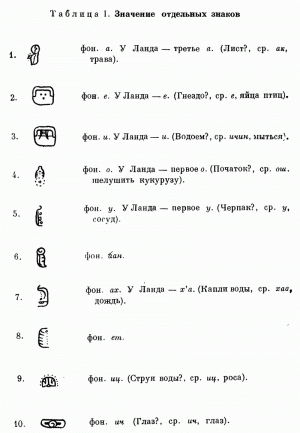 |
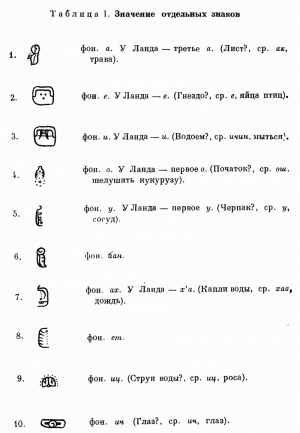 |
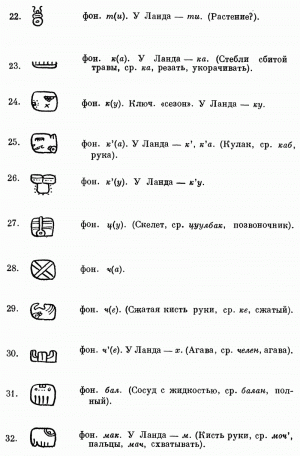 |
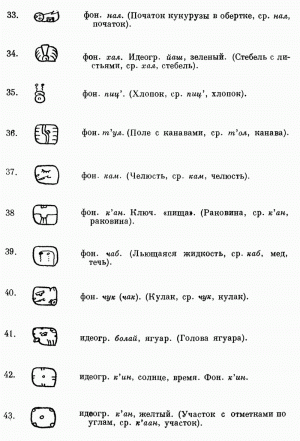 |
 |
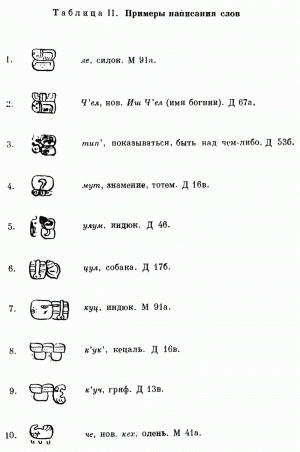 |
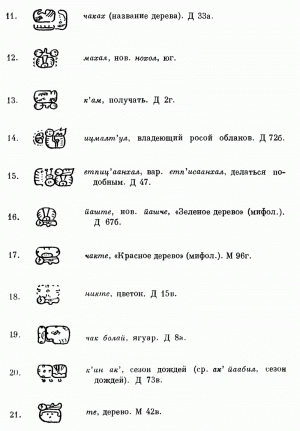 |
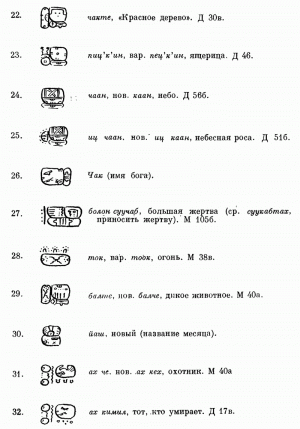 |
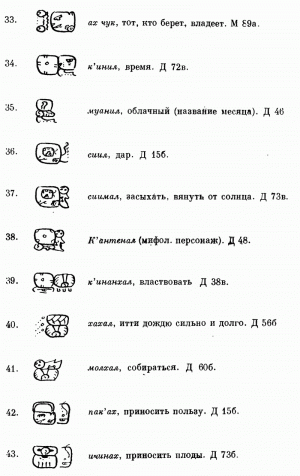 |
 |
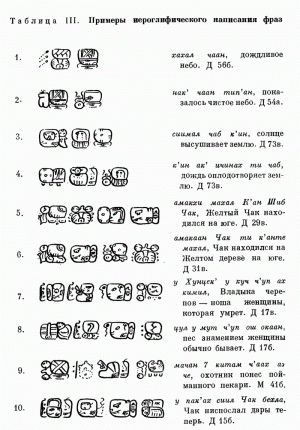 |
[1] Например: S. G. Мorley. An Introduction to the Study of the Maya Hieroglyphs. Washington, 1915; J. E. S. Thоmpson. Maya Hieroglyphic Writing. Introduction. Washington, 1950.
[2] D. Е. Ibarra Grasso. La Escritura Indígena Andina. La Paz. Bolivia, 1953.
[3] Все иероглифы, приведенные Ланда, подробно рассмотрены во вводной статье к советскому изданию: Диэго де Ланда. Сообщение о делах в Юкатане. Л., 1955.
ДОКЛАДЫ СОВЕТСКОЙ ДЕЛЕГАЦИИ НA X МЕЖДУНАРОДНОМ КОНГРЕССЕ ИСТОРИКОВ В РИМЕ
REPORTS OF THE SOVIET DELEGATIONS AT THE X INTERNATIONAL CONGRESS OF HISTORICAL SCIENCE IN ROME
Ю. В. КНОРОЗОВ
КРАТКИЕ ИТОГИ ИЗУЧЕНИЯ ДРЕВНЕЙ ПИСЬМЕННОСТИ МАЙЯ В СОВЕТСКОМ СОЮЗЕ
Y. KNOROZOV
A BRIEF SUMMARY OF THE STUDIES OF THE ANCIENT MAYA HIEROGLYPHIC WRITING IN THE SOVIET UNION
ИЗДАТЕЛЬСТВО АКАДЕМИИ НАУК СССР
Москва — 1955
Y. KNOROZOV
A BRIEF SUMMARY OF THE STUDIES OF THE ANCIENT MAYA HIEROGLYPHIC WRITING IN THE SOVIET UNION
PUBLISHING HOUSE OF USSR ACADEMY OF SCIENCES
Moscow — 1955
Ю. В. КНОРОЗОВ
КРАТКИЕ ИТОГИ ИЗУЧЕНИЯ ДРЕВНЕЙ ПИСЬМЕННОСТИ МАЙЯ В СОВЕТСКОМ СОЮЗЕ
A BRIEF SUMMARY OF ГНЕ STUDIES OF THE ANCIENT MAYA HIEROGLYPHIC WRITING IN THE SOVIET UNION
Archaeological research undertaken in Central America since the end of the 19th century has disclosed an ancient nidus of civilization similar to those of Sumer and Egypt. At present the history of Central America is known after the scanty, semi-fictional data preserved in such sources of information as come from the colonial period. To say nothing of its being fragmentary and unreliable, all such information dates back to events which did not occur till the 10th century A. D. At the same time, the Maya hieroglyphic monuments that were discovered among the ruins of ancient towns, as well as some monuments of the neighbouring peoples who had borrowed the graphic system of the Mayas, embrace a tremendous period of about one and a half milleniums and spread over an extensive territory — from the Mexican state of Veracruz to Salvador. The number of these monuments is quite sufficient to make them a reliable source of historical information. It is impossible to undertake a study of the civilization of Central America which ought to occupy a due place in world history without deciphering the Maya hieroglyphic writing.
The first attempts at deciphering refer to the middle of the 19th century when Kingsborough published the Dresden hie- roglyphic manuscript. By that time some explorers (Dupaix and Stephens) had discovered hieroglyphic inscriptions on stone in many places. In 1863 the French americanist Brasseur de Bourbourg found the work of Diego de Landa, entitled, Relación de las cosas de Yucatan and written in the year 1566.
The list of the Maya hieroglyphs with their phonetic equivalents given by Landa in his book (the so-called «Landa Alphabet») was the cause of an interminable controversy. The first investigators (the 19th century) tried to apply the «Landa Alphabet» to the reading of hieroglyphic texts. They proceeded from the conjecture that the Maya writing was of a purely phonetic character, this conjecture being wrong in its very principle. However, alongside with the many ridiculous interpretations they came to, some of them managed to read correctly several separate words in the extant codices. The erroneous method of reading predetermined the failure of the attempts at deciphering. In the majority of cases these authors believed the Mayas to have been connected, through Atlantis, with the peoples of the ancient Orient and sought to establish direct parallels between the Maya glyphs, on the one hand, and the Egyptian glyphs and even Greek letters, on the other. Later on, investigators gave up all attempts to read the hieroglyphs phonetically, agreed that the «Landa Alphabet» was the result of a misunderstanding and adopted the conception that the Maya hieroglyphs belonged to the class of ideographic writing. Such method of approach made the deciphering of the Maya writing theoretically unachievable, and the whole thing came to a standstill. After Forstemann had worked out the principles on which the writing of Maya numerals was based and after he had proved that there were special astronomic and calendric glyphs in the hieroglyphic codices, all the decipherers engaged themselves in the study of the Maya calendar.
The largest monographic works, presumably devoted to the Maya writing, are, as a matter of fact, nothing else than studies of the calendar.[1] To our regret, this trend of research, with the study of the calendar replacing the study of the graphic system, has prevailed up to the present day.
It should be mentioned that the experiments in deciphering were conducted very carelessly and on an extremely low theoretical level. For instance: the first attempt to compile a catalogue of glyphs (which, it seems, should have been done at the very beginning) was made only in 1931 by Gates, and proved to be an obvious failure: compound and simple glyphs are confused, quite different glyphs are regarded as variants of the same glyph, and, on the other hand, variants of one and the same glyph are regarded as different glyphs. The same glyph of the sun, kin, which occurs in the words yaxkin («new sun», a month name), chikin («the sunset», «west»), etc., is permanently used as an example of a phonetic glyph in all existing works, from the earliest to the latest, though just in these very casas where it is used, its function is ideographic, and even a most superficial acquaintance with any hieroglyphic system would help to reveal this. No wonder that all attempts at phonetic reading, the last one being that of Whorf (1941), proved fruitless and the «Landa Alphabet» was finally discarded. Things came to such a pass, that the most eminent specialists, and among them the coryphaeus of americanistics in Germany — Paul Schellhas — declared that the deciphering of the Maya graphic system was practically impossible.
In Iheir study of.the Maya graphic system’the Soviet scientists proceeded from their general conception of the deyelopment of society. Hieroglyphic writing appears among peoples living in different parts of the world at a definite stage of development, i. e. at the time when a transition from tribal forms of social life to a class society takes place. Its appearance is conditioned by the universal laws of development of. human society. Hence, there is no need to explain the similiarity of the civilizations of the Old and New Worlds by referring to a highly improbable ¡mutual influence. There is no need, either, to suppose that the Mayas used a system of writing different from that of the other most ancient civilizations; or that they used, for instance, an ideographic system (by the way, the existence of such a system, still has to be proved).
Many scientists are inclined to call any graphic system which uses more or less intricate signs, hieroglyphic and therefore they call the Maya writing both hieroglyphic and ideographic — at the same time. On the other hand, there, is a strongly pronounced tendency to deny the very existance of hieroglyphic systems of writing in general; as a result, the graphic systems of the Egyptians, Sumerians, etc., are regarded as a transition from an ideographic system to an alphabetic one. It follows that all the ancient civilizations used this «transition» system of writing while the initial and basic ideographic system was never used at all. Only a misunderstanding can lead to calling the Chinese graphic system ideographic, and after the excellent work of Ibarra Grasso[2] it is no longer possible to speak about the ideographic character of the ancient Peruvian writing.
In reality hieroglyphic writing descends diróctly from pictography and represents the most ancient system of recording human speech. The most characteristic attributes of the hieroglyphic system are: the use of three categories of symbols, or glyphs (namely, ideographic, phonetic and determinative), the polysemantism of those glyphs, and the approximateness of conveying the idea of the phonetic composition of words.
The graphic system of the Mayas seems to have originated in the first centuries of our era in the most ancient town-states of Central America, to the north-east of Lake Peten Itza (the department Peten in Guatemala). Without any essential changes it was passed down to the limes of the Spanish conquest (16th century). The priests ascribed the invention of writing to the god Kinich Ahau («The Sun-eyed Lord»); writing was considered sacred and was practised almost exclusively among the priests. The prevailing hieroglyphic texts were of the calendric, ritual, mythological, historic or prophetic character. It is probable that epic poems, dramatic works and such like were also recorded. Certain fragments from the so-called Books of Chilam Balam, written in the Maya language, but in Spanish letters, at the time of the colonial period, are supposed to be a transliteration of hieroglyphic texts and, can, to a certain degree, give an idea as to what the ancient Maya literature was like. A thin brush served as a writing tool, while paper was made of the bark of the Ficus cotonifolia. Coloured drawings usually appear in the codices side, by side with rows of glyphs. This accounts for the fact that we find veritable little drawings amid glyphs and glyphs amid drawings. Inscriptions on stone were made in special, «lapidary» characters, and the glyphs here sometimes greatly differ from the glyphs used in the codices. Many glyphs were set into ovals of different configurations. The total number of glyphs is about 270, but some of them occur very seldom; the number of the more widely used glyphs amounts to 170.
In many cases it is quite easy to determine what object is depicted by this or that glyph, though the meaning óf some other glyphs still remains obscure. The glyph usually represented the side view of the object. As a rule, the bodies of men and animals are not seen, only their heads being traced (the «facial» glyphs). Many of the glyphs are connected with milpa agriculture (field, rain, fire, plants) and hunting' (weapons, animals). Certain glyphs depict utensils or parts of the human body, especially the arm in different positions.
Glyphs belonging to the ideographic class convey whole words, simultaneously indicating their phonation and meaning. The meaning of some of the glyphs directly corresponds to the fully or partially depicted object. Thus, for instance, the head of a jaguar (bolay) represents the ideogram bolay — «jaguar»: streams of water (ak) falling upon undulate ground stand for the ideogram ak — «rain». (See table I, Nos. 41 and 44). In other cases the meaning of the ideogram corresponds to a certain attribute of the depicted object; thus, for instance, the picture of a plant (hal) is the ideogram yax — «green» (Table I, No. 34). A number of ideograms are formed by utilizing homonyms; for instance, the graphic representation of a plot of land with marks at the corners (kaan) makes the ideogram kan — «yellow» (Table I, No. 43).
The greater part of the glyphs belong to the phonetic class. The phonetic meaning of the glyph usually corresponds to the first sound of the name of the depicted object. Thus the picture of a pond (paa) is the phonetic symbol of p(a), the picture of a hand (kab) — that of k(a). Phonetic glyphs are divided into the following groups.
- Alphabetic glyphs of the A type which signify vowels (a, e, і, о, и). These glyphs are used to express the initial or final vowel of a word (See Table II, Nos. 1, 5 and 21). Vowels standing in the middle of a word are expressed by these glyphs only on solitary instances (Table II, No. 3).
- Syllabic glyphs of the AB type signifying a vowel with a successive consonant.
- Syllabo-alphabetic glyphs of the B(A) type which may signify either a consonant with a successive vowel, or a single consonant. These glyphs are commonly used as alphabetic ones at the end of words and as syllabic ones at the beginning or in the middle of them (See Table II, Nos. 4—10). In the majority of cases, when glyphs of the B(A) type are used as syllabic, they express a definite vowel, for instance: z(uu), к (a), k(u), etc. But some of the glyphs of the B(A) type seem to display a tendency to become alphabetic and in a number of cases express only a consonant, even when standing at the beginning of a word.
- Syllabic glyphs of the BAB type which signify closed syllables (consonant-vowel-consonant). They are used for writing both roots and suffixes of words.
In the process of reading one may develop the impression that the same glyphs of the B(A) or BAB type may convey different vowels. Thus, for instance, the glyph depicting a clenched fist (Table I, No. 29) is used for writing the words che («deer») and chikin («west»). But one ought to keep in mind that the words of the Maya language which are known to us from sources not occurring before the 16th century could have had in ancient times a different phonation of vowels, and it is probable that the word «west» was at one time pronounced chekin.
In addition to the ideographic and phonetic glyphs there are some determinative glyphs which occur rather seldom. The determinatives are not to be read; they only serve to illustrate the meaning of a word recorded by means of phonetic or ideographic glyphs. (Table II, Nos. 26—30).
The same glyphs may be alternately used either as ideograms, or phonetic and even determinative glyphs. Thus, for instance, the glyph depicting the stem of a plant (Table I, No. 34) in some cases is read as the ideogram yax— «green»; in other cases as the phonetic symbol hal. The determinative glyph which stands for «season» in certain cases is read phonetically, as cu (Table II, No. 7; Table III, No. 7). The ideogram of the sun (Table I, No. 42) may be used in the capacity of the phonetic glyph standing for kin (Table II, Nos. 23 and 45).
In many cases the Maya scribes indicated the function of this or that glyph by means of a special sign («semantic indicator»; Table I, No. 50). Thus, the glyph depicting a clenched fist (Table I, No. 29) is commonly read phonetically as ch(e), but if it was used as the ideogram che — «deer», it was furnished with a «semantic indicator» (Table II, No. 10). The same «semantic indicator» accompanies (though not constantly) the glyph depicting the stem of a plant whenever this glyph should be read phonetically — hal, and not ideographically — yax — «green» (Table II, Nos. 12 and 39).
The glyphs which compose a word are usually written left to right and top to bottom, but they can be turned at the angle of 90° and even 180°. Some glyphs, however, always occur in the same position. The place of the determinative glyph is not stationary. It may stand at the beginning, at the end and in the middle of a word. Occasionally we meet with ligatures (kuk— Table II, No. 8) and with an insertion of one glyph into another, the inserted glyph being read after the original one.
There are violations oí the usual order of glyphs (inversion) when the glyph that should have been placed lower is written higher (chacte; Table II, No. 22). Lastly, there are cases of abridged, or incomplete, writing when one of the glyphs is omitted altogether (for instance, che instead of chikin in page 6a of the Madrid Codex (Codex Tro-Cortesiansus).
A word may be written by glyphs of different types. Sometimes there occurs purely phonetic writing, sometimes purely ideographic. A phonetic or ideographic writing may be supplemented with a determinative glyph, especially when there is a need to discriminate homonyms. In compound words there occur combinations of several ideograms, or combinations of ideograms with phonetic glyphs. An additional phonetic glyph (usually of the BAB type) may be written after a preceding, phonetic glyph to confirm its phonation. For instance, the words chacte, piokin, chaan (Table II, Nos. 22—24) in full transliteration are to be written: chac-te-e, pio-kin-n, chaan-n. This device is called «phonetic complement».
The number of phonemes in the Maya language is 35; they are: a, aa, a’, e, ее, e’, i, ii, i', о, oo, o', и, uu, u’, у, v, l, m, n, b, z, x, h, h, p, pp, t, th, c, k, tz, э, ch, ch’.
Each of the five basic vowels has three variants — the common one, the long one and the common one with the glottal stop («saltillo»). All the unvoiced occlusive consonants and the affricates occur in two variants — the common one and the one with the saltillo. The study of the phonetics of the Maya language is impeded by a number of circumstances. The words of the Maya language became known to us in the form in which they were transcribed in the so-called «traditional alphabet», based on the Spanish alphabet of the 16th century.
In this transcription the length of vowels is not always indicated, vowels with the saltillo have no special marks, weak and intensified variants of the h sound are not discriminated, the phonemes m and n are sometimes confused, and, lastly, the phonemes и, v and b are found transcribed by the same letter. As for the hieroglyphic writing, it had no special glyphs for long vowels or for vowels with the saltillo. Sometimes a long vowel was expressed by doubling the alphabetic glyph (moo, D 16c) or by a syllabic glyph (zii, zuu\ Table I, Nos. 16—17). The two variants of the unvoiced (surd) occlusives and the affricates, i. e., the common variant and the saltillo variant, were conveyed by different phonetic glyphs (ca — ka, cu — ku, che — ch'e; Table I, Nos. 23—26 and 29—30).
In many cases hieroglyphic writing differs from the transcription of the same word in the traditional alphabet, and it is not always clear whether it is to be accounted for by certain historical shifts of sounds in the words of the Maya language or by inaccuracy in the transcription. Then, to judge by the Diccionario de Motul and the Books of Chilam Balam, a number of words had an alternative pronunciation. Nevertheless, sometimes it is possible to speak more or less definitely about vowel gradation; for instance, the word nohol in the hieroglyphic writing is given as mahal (Table II, No. 12). The historically developed interchange of consonants seems to be somewhat clearer. Thus t interchanges with ch (yaxte — yaxche) and ch interchanges with с (caan — chaan). The two variants of the unvoiced occlusives and of the affricates also interchange, but in some cases we may suppose that the scribes used the glyphs inaccurately. The interchange of the consonants m and n also occurs at times (suffix mal — nal; Table II, Nos. 37—38). In some cases we seem to have alternative pronunciation and not a historical interchange of sounds. The weak h sound may disappear (keh — che; Table I, No. 10).
Specimens of separate glyphs are given in Table 1: Nos. 1—15 are glyphs of the alphabetic A type; Nos. 6—10 of the syllabic AB type; Nos. 11—30 of the syllabo-alphabetic B(A) type; Nos. 31—40 of the syllabic BAB type; Nos. 41—45 are ideographic glyphs and Nos. 46—50 are determinative glyphs. The phonetic, ideographic and determinative meaning of the glyphs is indicated by the abbreviations: phon., ideogr., determ, (respectively). The name of the object presumably depicted by the glyph is given in parentheses. In the cases when the same glyph occurs in the «Landa Alphabet», special reference is given. Though the «Landa Alphabet» did not serve as a basis for the method of deciphering offered in the present paper, still it can be considered an additional proof of the correctness of our interpretations. In a number of cases the glyphs from the «Landa Alphabet» do not represent the pronunciation, but stand for the name of the corresponding letter of the Spanish alphabet. For instance, the glyph ch'e (Table 1, No. 30) corresponds to the letter hache. Moreover, in this «alphabet» we see not only syllabo-alphabetic glyphs of the B(A) type, but also syllabic glyphs of the BAB type (see, for instance, mac Table I, No. 32).[3]
Table II gives some specimens of hieroglyphic writing of words with references to the pages of the Maya codices (D — stands for the Dresden Codex and M — for the Madrid Godex). Nos. 1—15 are specimens of a purely phonetic writing by means of syllabo-alphabetic glyphs of the B(A) type, alphabetic glyphs of the A type (Nos. 1, 3, 5) and syllabic glyphs of the BAB type (Nos. 12, 14, 15). These are followed by some specimens of purely ideographic writing (Nos. 16—20), and some specimens of phonetic complements (Nos. 21—25); then come some specimens of determinative glyphs (Nos. 26—30) and lastly some specimens of words with different affixes (Nos. 31—50): with the prefix ah-, and the suffixes -il, -mal, -nal, -hal, -ah, -cunah, -cinah, -r-zah, -aan, -bal. Some of the examples require special comments. No. 2: feminine names in the hieroglyphic writing are written without the prefix ix, for in the ancient language this suffix was not used to form personal names. No, 14: Lizana gives an interpretation of the word itz- malthul: he records this word in the form of Itzmatul, as the name of a god. No. 16: the lower glyph is the ideogram te, i. e. «tree», «plant». No. 17: the glyph at the top is the ideogram chac, i. e. «red», No. 18: the glyph at the top is the ideogram nic, i. e. «flower»; the word nicte occurs in two paragraphs of the Dresden Codex (D 12 c, 15 c), when the text is concerned with a marriage ceremony: kam nicte (lit. «the receiving of a flower»). No. 27: the numeral bolon («ліне») means also «many»; cf. bolon oacab — «denial». No. 32: the more probable reading is ah camel; the last glyph is commonly used to express the suffix -l, with a preceding vowel, according to the rule of sinharmo- nism. No. 38: Ah Kantenal is mentioned in the Chilam Bal am book from Chumayel. No. 42: Pakah means also «lo swarm» (about bees), «to bring honey» (see M 103—109) and «to paint» (see M 64 b). No. 43: the lower glyph reads phonetically as in. No 46: the numeral ox («three») means also «many». No. 48: see instances of the use of the participle ocaan in Motul’s dictionary. No. 49: this is a participle formed from the verb anac'hal, the root being anac — «the one who is present».
Table III gives examples of the hieroglyphic writing of phrases. Some of the phrases require special comments.
No. 2: Nakchaan means «the cover of the heavens»; the first glyph, which depicts a man in a sitting posture, is read phonetically as пак (cf. with the classification suffix of numerals пае which is used to count sitting men); tippan means «appearing»: cf. with tippan kin — «the sun has risen». No. 3: the phrase may be also translated as follows — «the time of the drying up of earth»; chab (cab) means «land»; the lower glyph seems to be used as a phonetic complement. No. 6: cf. with a similar use of the participle in a phrase from a prophetic text: vaan ti peten Buluc Ch'abtan—«set up in the district, is Buluc Ch’abtan». No. 7: the reading of the name of the god is suppositional: it is expressed by two glyphs of which the first may be read phonetically — on (un, hun), while the second is the ideogram tzek — «skull»; cuch — «burden»; the lower glyph is read phonetically — сh’(a); the reading ch’ир («woman») is suppositional; in the ancient language the suffix ah- did not indicate masculine gender (cf.: in Motul’s dictionary — ah al— «woman in child birth»; ah icham— «a married woman»). No. 9: the reading of the ideogram of peccary is suppositional (the glyph depicts a bracelet). No. 10: the reading behla (behlae) is suppositional.
The present paper is a preliminary publication of some of the materials of a monographic work — «The Written language of the Maya Indians» — which is being prepared by the Ethnographical Institute of the Academy of Sciences of the USSR.
The above brief outline of the graphic system of the Mayas cannot, and does not, pretend to be exhaustive. Nevertheless the data we have used in the paper clearly testify to the fact that in ist basic principles the Maya writing does not differ from the other hieroglyphic systems known to us. The Maya glyphs are unequivocally of local origin and have never been borrowed from other peoples, for the phonetic meaning of the glyphs corresponds to the names of the objects depicted. The very choice of the hieroglyphic picture-objects may serve to illustrate the Maya economy, which was based on milpa agriculture. When compared to other hieroglyphic systems, the Maya hieroglyphs have some distinguishing features of their own (for instance, the wide use of syllabo-alphabetic glyphs); this is mainly accounted for by the peculiarities of the Maya language. At present, when the meaning of the majority of glyphs is established to a sufficient degree of certainty, there is no doudt that further investigations will soon make accessible all the extant historic texts of ancient Central America.
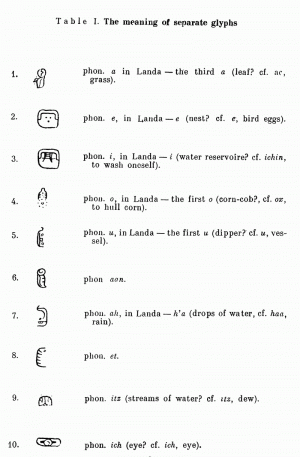 |
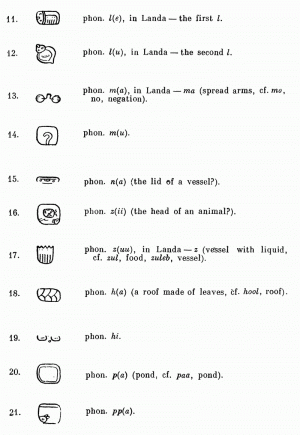 |
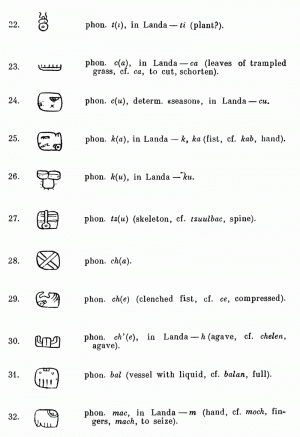 |
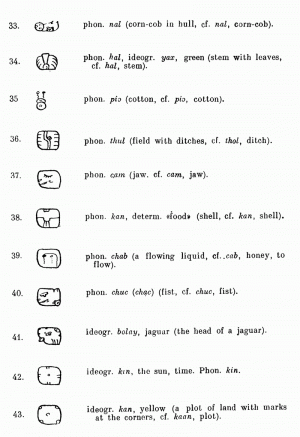 |
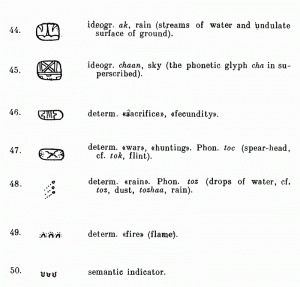 |
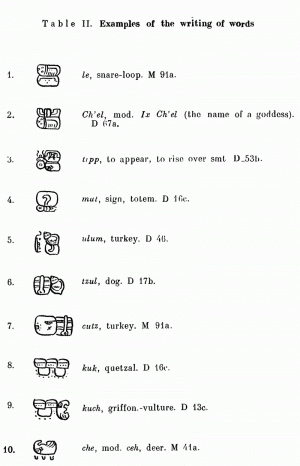 |
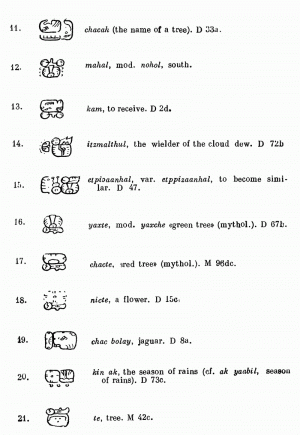 |
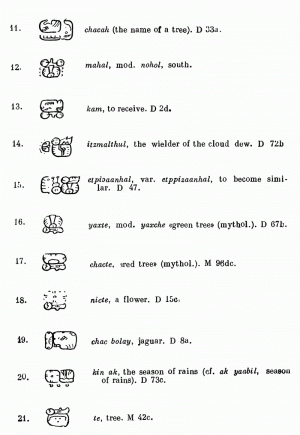 |
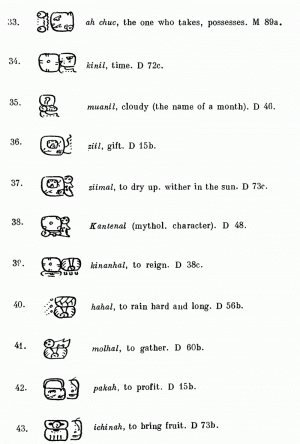 |
 |
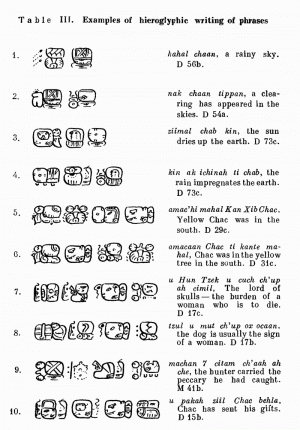 |
[1] See, for instance: S. G. M о r 1 e y, An Introduction to the Study of the Maya Hieroglyphs, Washington, 1915; and also, J. Eric S. Thompson, Maya Hieroglyphic Writing. Introduction. Washington, 1950.
[2] D. E. I b a r r a Grasso, La Escritura Indígena Andina. La Paz. Bolivia, 1953.
[3] All the hieroglyphs given by Landa have been discussed in full in the introductory article to the Soviet edition of his book (Leningrad, 1955).
Источник - Доклады Советской делегации на X международном конгрессе историков в Риме. Изд-во Академии наук СССР, М., 1955
